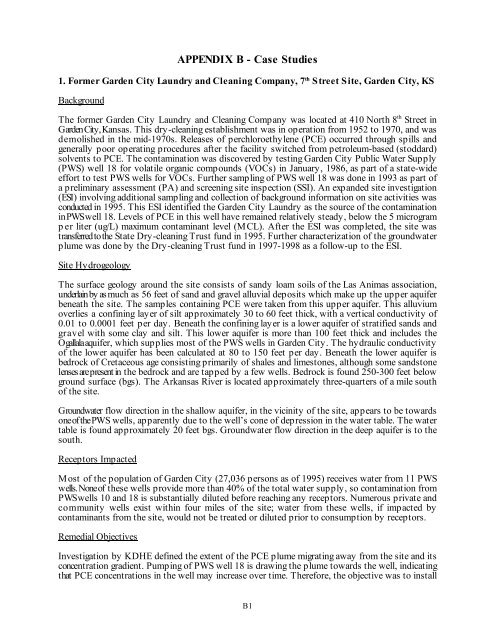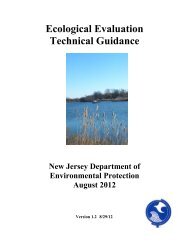Technical and Regulatory Guidance for In Situ Chemical ... - ITRC
Technical and Regulatory Guidance for In Situ Chemical ... - ITRC
Technical and Regulatory Guidance for In Situ Chemical ... - ITRC
You also want an ePaper? Increase the reach of your titles
YUMPU automatically turns print PDFs into web optimized ePapers that Google loves.
APPENDIX B - Case Studies<br />
th<br />
1. Former Garden City Laundry <strong>and</strong> Cleaning Company, 7 Street Site, Garden City, KS<br />
Background<br />
th<br />
The <strong>for</strong>mer Garden City Laundry <strong>and</strong> Cleaning Company was located at 410 North 8 Street in<br />
Garden City, Kansas. This dry-cleaning establishment was in operation from 1952 to 1970, <strong>and</strong> was<br />
demolished in the mid-1970s. Releases of perchloroethylene (PCE) occurred through spills <strong>and</strong><br />
generally poor operating procedures after the facility switched from petroleum-based (stoddard)<br />
solvents to PCE. The contamination was discovered by testing Garden City Public Water Supply<br />
(PWS) well 18 <strong>for</strong> volatile organic compounds (VOCs) in January, 1986, as part of a state-wide<br />
ef<strong>for</strong>t to test PWS wells <strong>for</strong> VOCs. Further sampling of PWS well 18 was done in 1993 as part of<br />
a preliminary assessment (PA) <strong>and</strong> screening site inspection (SSI). An exp<strong>and</strong>ed site investigation<br />
(ESI) involving additional sampling <strong>and</strong> collection of background in<strong>for</strong>mation on site activities was<br />
conducted in 1995. This ESI identified the Garden City Laundry as the source of the contamination<br />
in PWS well 18. Levels of PCE in this well have remained relatively steady, below the 5 microgram<br />
p er liter (ug/L) maximum contaminant level (MCL). After the ESI was completed, the site was<br />
transferred to the State Dry-cleaning Trust fund in 1995. Further characterization of the groundwater<br />
plume was done by the Dry-cleaning Trust fund in 1997-1998 as a follow-up to the ESI.<br />
Site Hydrogeology<br />
The surface geology around the site consists of s<strong>and</strong>y loam soils of the Las Animas association,<br />
underlain by as much as 56 feet of s<strong>and</strong> <strong>and</strong> gravel alluvial deposits which make up the upper aquifer<br />
beneath the site. The samples containing PCE were taken from this upper aquifer. This alluvium<br />
overlies a confining layer of silt approximately 30 to 60 feet thick, with a vertical conductivity of<br />
0.01 to 0.0001 feet per day. Beneath the confining layer is a lower aquifer of stratified s<strong>and</strong>s <strong>and</strong><br />
gravel with some clay <strong>and</strong> silt. This lower aquifer is more than 100 feet thick <strong>and</strong> includes the<br />
Ogallala aquifer, which supplies most of the PWS wells in Garden City. The hydraulic conductivity<br />
of the lower aquifer has been calculated at 80 to 150 feet per day. Beneath the lower aquifer is<br />
bedrock of Cretaceous age consisting primarily of shales <strong>and</strong> limestones, although some s<strong>and</strong>stone<br />
lenses are present in the bedrock <strong>and</strong> are tapped by a few wells. Bedrock is found 250-300 feet below<br />
ground surface (bgs). The Arkansas River is located approximately three-quarters of a mile south<br />
of the site.<br />
Groundwater flow direction in the shallow aquifer, in the vicinity of the site, appears to be towards<br />
one of the PWS wells, apparently due to the well’s cone of depression in the water table. The water<br />
table is found approximately 20 feet bgs. Groundwater flow direction in the deep aquifer is to the<br />
south.<br />
Receptors Impacted<br />
Most of the population of Garden City (27,036 persons as of 1995) receives water from 11 PWS<br />
wells. None of these wells provide more than 40% of the total water supply, so contamination from<br />
PWS wells 10 <strong>and</strong> 18 is substantially diluted be<strong>for</strong>e reaching any receptors. Numerous private <strong>and</strong><br />
community wells exist within four miles of the site; water from these wells, if impacted by<br />
contaminants from the site, would not be treated or diluted prior to consumption by receptors.<br />
Remedial Objectives<br />
<strong>In</strong>vestigation by KDHE defined the extent of the PCE plume migrating away from the site <strong>and</strong> its<br />
concentration gradient. Pumping of PWS well 18 is drawing the plume towards the well, indicating<br />
that PCE concentrations in the well may increase over time. There<strong>for</strong>e, the objective was to install<br />
B1
















